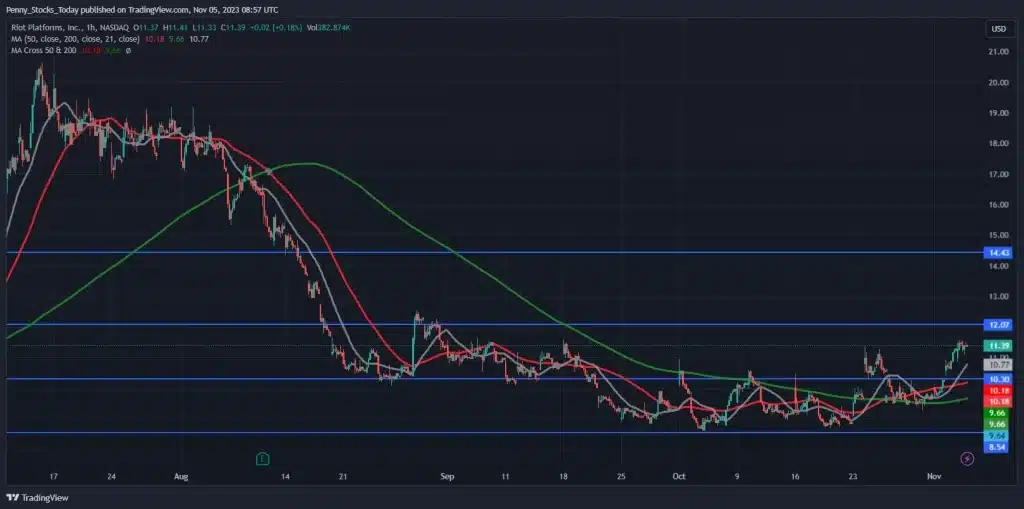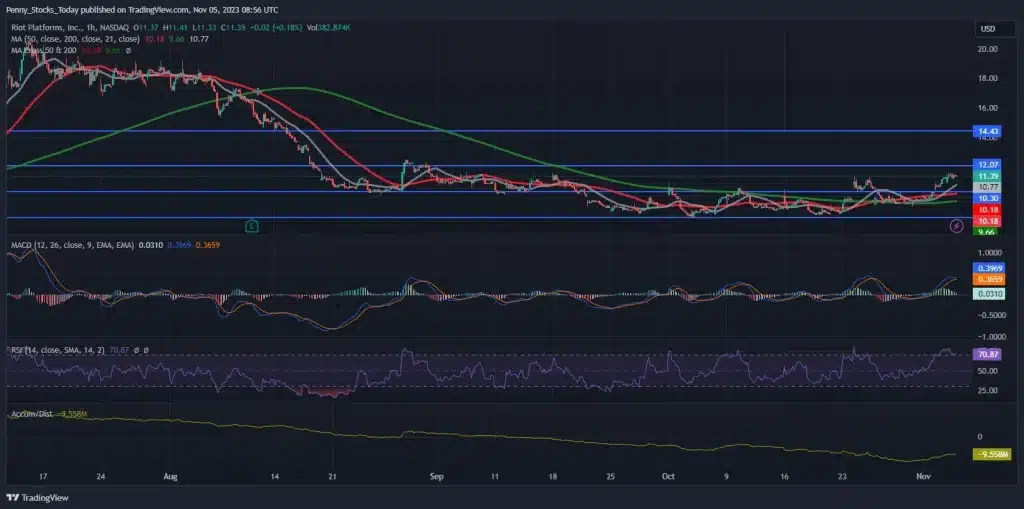Although Bitcoin mining stocks are outperforming the market so far this year, they have been on a steady decline since early August. Riot Platforms, Inc. (Nasdaq: RIOT) is one of these stocks that have been hit hard as its stock is down nearly 45% from the highs it reached last July. That said, this dip could be an opportunity to go long on the stock ahead of 2 major Bitcoin catalysts that should boost the cryptocurrency’s price. The first catalyst is the approval of spot Bitcoin ETFs as analysts expect the SEC to approve spot ETF applications later this year. In addition, we are approaching the Bitcoin halving which has seen the cryptocurrency spike after the past 3 halvings. Given our $20 price target on RIOT stock, investors may find the current levels an attractive entry point into the Bitcoin miner’s stock.
RIOT Stock News
Bitcoin Tailwinds Will Help Miners Rebound
While some investors believe holding Bitcoin may be the best strategy to participate in this sector, Bitcoin miners have proven to provide higher returns. On a YTD basis, Bitcoin is up 84.5%, while RIOT stock more than tripled gaining nearly 155% over the same period. This isn’t exclusive to Riot only as other miners like Marathon (Nasdaq: MARA) and Hut 8 (Nasdaq: HUT) are also up by 117% and 118%, respectively.
As such, investing in Bitcoin miners, especially after their massive drop since early August, could be opportune as it seems likely that Bitcoin is heading into a major bull market. The most important catalyst for Bitcoin is the upcoming halving that is expected to occur next April. This event is significant since the supply output will be cut in half which means that block rewards will decrease from 6.25 BTC to 3.125 BTC.
With that in mind, Bitcoin prices have historically benefited from halving events as data shows that the cryptocurrency’s price spiked before the previous 3 halvings. This is due to Bitcoin’s inflation rate declining with every halving. Before the first halving, Bitcoin surged by as much as 234% since the start of 2012 until the event occurred on November 8.

However, a bigger movement occurred after the halving where Bitcoin increased by more than 9400%, reaching a then all-time high of $1165 in November 2013.

The second halving occurred on July 9, 2016, and in the year prior to the event, Bitcoin increased by as much as 400%.

Meanwhile, the cryptocurrency surged more than 2948% in the year after the halving before entering a bear market.

This trend also occurred prior to the third halving that occurred on May 11, 2020. Over the year prior to the event, Bitcoin increased by as much as 291%.

Following the occurrence of the event, Bitcoin went on to reach its all-time high, increasing by 690% in the process in November 2021, before entering the “crypto winter” of 2022.

That being said, Bitcoin appears to be on the same trajectory since the cryptocurrency is currently up nearly 100% from the lows it reached in November 2022.

However, it should be noted that these major runs take time to materialize, so Bitcoin price may not be impacted by the halving event immediately.
The other major catalyst for Bitcoin is the likely SEC approval of spot Bitcoin ETFs. The SEC has previously denied applications for spot Bitcoin ETFs. However, its stance may change after a Court of Appeals ruled that the SEC was wrong to reject Grayscale’s (GBTC) proposed Bitcoin ETF, a ruling the SEC decided not to appeal.
The SEC’s decision likely paves the way for the approval of other spot Bitcoin ETFs, including Grayscales’s. As is, House lawmakers recently urged the SEC to approve all outstanding applications “immediately”, in a letter sent by 4 members of the House Financial Services Committee to SEC Chair Garry Gensler.
Meanwhile, Wall Street analysts expect the SEC to approve spot Bitcoin ETF applications before January 10, 2024. This is mainly due to major institutions filing their applications for spot Bitcoin ETFs including BlackRock, Fidelity, Ark Invest, Invesco, Valkyrie, and others. Given the size of these institutions, Morgan Creek Capital’s CEO – Mark Yusko – expects the approval of spot ETFs to result in an influx of $300 billion into Bitcoin.
This projection could lead to a major run in Bitcoin price considering that the percentage of total Bitcoin supply held by long-term investors is at an all-time high at 80.34%. This is mainly due to the expected demand outpacing the amount of Bitcoin available to trade.
RIOT’s Edge
Although the aforementioned catalysts will certainly impact all Bitcoin miners, Riot is well-positioned to benefit the most due to its sound margins and cost management. According to its latest Q2 earnings report, Riot’s average cost of mining is $8,389 per Bitcoin. In comparison, its competitor Marathon had an average cost of $18,873 per Bitcoin, more than double that of Riot. These elevated costs are impacting Marahon’s gross margin which was 33.3% in the first half of the year, while Riot’s mining operations had a gross margin of 53.4% over the same period, despite having lower production.
That said, a reason why Riot is operating more efficiently is that it operates in Texas. Thanks to the state’s unregulated electricity market, consumers are allowed to sell unused energy to the grid. As such, Riot can earn power curtailment credits to offset costs which is extremely helpful when energy costs are more profitable than mining operations.
Riot has already utilized this advantage as it received $31.7 million last August by providing 84 thousand megawatt hours of energy to the market in Texas to reduce overall demand, lower consumer prices, and stabilize the grid during a heatwave. The miner also received $13.5 million in credits in September due to the same reasons which are the equivalent of mining 511 Bitcoin based on the average price of Bitcoin in September.
Another advantage of operating in Texas is the lower power costs as the average Texas commercial electricity rate is 9.07 ¢/kWh – nearly 31% lower than the national average of 13.11 ¢/kWh, per the US Energy Information Administration.
Given Riot’s impressive cost structure, it appears to be ready to face the challenges brought by the upcoming Bitcoin Halving. While the halving will potentially have a positive impact on Bitcoin prices, that may not be the case for all miners. Some investors argue that the increased rate of mining difficulty brought about by the halving will lead to more costs for miners.
While this point is valid to a degree, it should be noted that Bitcoin’s price has historically increased in the months leading to the Bitcoin halving as discussed earlier. As such, the amount of Bitcoin needed to be mined to be profitable is also less.
Therefore, having a lower electricity cost than competitors starts to become a major competitive advantage for Riot since its power costs are less than most miners due to its location in Texas. In this way, its margins could further improve in case Bitcoin goes on a similar run leading to the upcoming halving as it did the past 3 halvings.
Price Target
With its stock trading at $11.39, Riot may be undervalued at current levels. Since the miner doesn’t have any long-term debt on its balance sheet, its book value amounts to more than $1.2 billion. This means that at its latest reported outstanding share count of 185.3 million, its book value per share is $6.7, leading to a P/B ratio of 1.7. Considering that an adequate P/B ratio is 3, Riot should be trading at $20.09, representing a 76.3% upside.
| Total Assets | $1,358,930,000 |
| Total Liabilities | $118,020,000 |
| Book Value | $1,240,910,000 |
| OS | 185,305,831 |
| BVPS | $6.70 |
| Share Price | $11.39 |
| P/B Ratio | 1.70 |
| Projected Share Price | $20.09 |
Risks
There are 2 major risks to the bullish thesis on RIOT stock. The first risk is Bitcoin prices not increasing as anticipated due to the upcoming halving. That could have catastrophic impacts on miners since they would realize less revenue while their costs would increase due to the greater mining difficulty. As a result, any chance of Riot becoming profitable would be non-existent.
The second risk to the bullish thesis is if the SEC doesn’t approve the spot Bitcoin ETF applications next year as analysts expect. Despite the court ruling in favor of Grayscale in its case against the SEC, it doesn’t guarantee that the commission will approve the applications it has on hand. As such, this could be an issue that requires an intervention by lawmakers to set frameworks for spot Bitcoin ETFs.
Media Sentiment
@IncomeSharks is bullish on RIOT stock’s chart.
@CalebFranzen is watching Bitcoin mining stocks including RIOT stock ahead of a potential crypto and equities bull market.
Technical Analysis

On the hourly chart, RIOT stock is in a neutral trend as it is trading in a sideways channel between $10.3 and $12. Looking at the indicators, the stock is above the 200, 50, and 21 MAs which is a bullish signal. However, the RSI is overbought at 70 and the MACD is approaching a bearish crossover. Based on this, the stock may retest its $10.3 support as profit-taking occurs which could be an ideal entry point for bullish investors.

As for the fundamentals, RIOT stock appears to be a bargain at current levels given its potential to reach $20. Such an increase in the stock’s value would be mainly driven by the anticipated increase in Bitcoin price due to the upcoming SEC decision on spot Bitcoin ETFs and the halving that is expected to occur next April. Therefore, crypto bulls may find RIOT stock to be attractively valued at current levels given Bitcoin miners’ history of outperforming Bitcoin in terms of percentage gains.
RIOT Stock Forecast
To conclude, Riot is well-positioned to capitalize on a potential Bitcoin rally ahead of the upcoming halving next April which could be fueled by the SEC approving spot Bitcoin ETFs. The reason why Riot may benefit the most from these catalysts is its industry-leading average cost per mined Bitcoin which is the result of its lower power costs since it operates in Texas. This advantage will be more important when the Bitcoin halving occurs since the more difficult mining difficulty will lead miners to incur more costs. With no debt on its balance sheet, RIOT stock should be trading near $20.09 based on its BVPS and P/B ratio, which is why the current share price could be an attractive entry point into the promising Bitcoin miner.
If you have questions about RIOT Stock and where it could be heading next feel free to reach out to us in our free alerts room!
Disclaimer
Please visit and read our disclaimer here.









